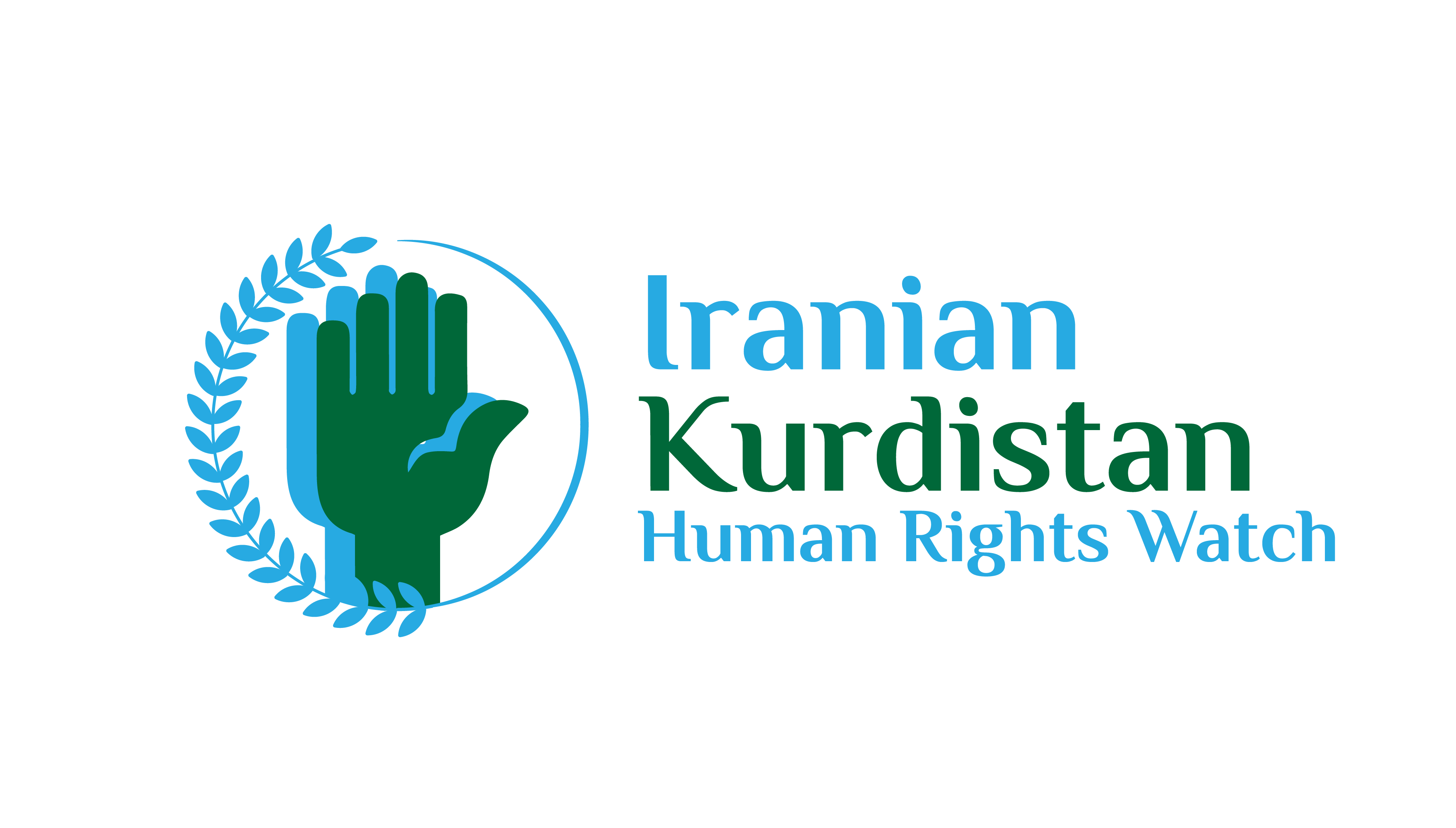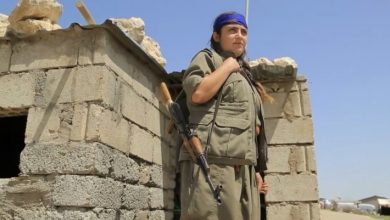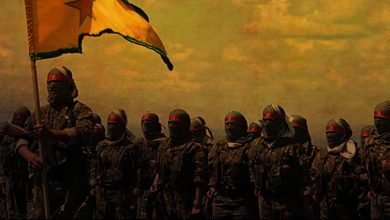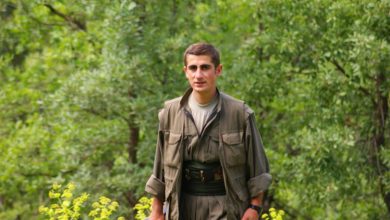By Hedwig Kuijpers
Since the Kibbutz movement in the early 20th century, and Murray Bookchin’s writings and influence in
leftist circles from the ’60s untill today, early Zionist anarcho-communism has become a heritage that
inspired both the Antifa movement in the West and the Kurdistan Workers’ Party in the Middle-East, and has united them in battle in Syria today.
Bookchin’s ideology
The ideological link that connects the chain between the Occupy Wallstreet movement, the ANTIFA movement that has hijacked Black Lives Matter protests throughout the US, and the Syrian-Kurdish self-proclaimed Autonomous Administration and its armed wing, the YPG, is the ideology written by Murray Bookchin, an American anarcho-communist with a Zionist background. Murray Bookchin is revered close to a saint in the anarchist community in the West. His ideas that he termed “libertarian municipalism” and “communalism” have influenced generations of self-declared leftists in the US and Europe, and he was cited frequently as the ideological force between the anti-globalization and Occupy Wallstreet

movements.
Bookchin was – unlike many of his anarchist and leftist peer writers – very soft and sometimes even downright apologetic when it comes to imperialism and zionism, leading to a less negative approach to his followers’ actions by the imperialist and zionist-supportive US government. The adoption of democratic confederalism by the Kurds Murray Bookchin became especially influential in the Middle-East through Kurdish circles. Abdullah Ocalan – leader of the Kurdistan Workers’ Party (known as the PKK) adopted his ideas to advance a “vision of democratic confederalism”, which his followers attempted later to implement in North-East Syria – backed by the US government.
Ocalan needed Bookchin’s theories to create a new ideological building plan. The PKK had before solely adopted a Maoist-Communist ideology and guerrilla warfare techniques, as it mainly focused on the insurgence it waged against the Turkish state, in order to “democratize” Turkey. The PKK has never really been a seperatist movement and has never aimed for an independent Kurdistan. After the adoption of a version of Bookchin’s ideology, the PKK sought to expand its efforts throughout Turkey’s neighbouring countries that host a Kurdish population. It founded PCDK in North-Iraq, PJAK in Iran and the PYD in Syria. All these parties operate under the PKK’s umbrella group KCK, and eventually aim for the balkanization of the Middle-East as a whole on the long run, by introducing a loose federal system
that decentralizes power over smaller “cantons” and “communities” and replaces the central governments as a whole, that they call “democratic confederalism”. The US can only applaud this plan, as the succeeding of this plan leads to a radical decrease in power or the toppling of the Middle-Eastern governments it fears most. Anarcho-communism, US-support and Israeli history Now let’s get back to Bookchin’s zionist background and the reasons the US government has always closed an eye to what others might perceive as “radical leftism” and a “danger to the traditional state”.

The main reason for this was that Bookchin was a Zionist who publicly whitewashed -and even rationalized – Israel’s crimes against the Palestinians and humanity as a whole. He also frequently demonized independent post-colonial governments in the Global South, echoing imperialist propaganda and chauvinistic myths about Latin-American countries targeted by the United States for regime change. Some rumours even spread throughout the 80’s in communist circles, stating that Bookchin was a government agent.
In 1986 Bookchin published a liberal Zionist creed. The essay uncritically denies Hasbara talking points, erases the history of the ethnic cleansing of indigenous Palestinians, and blames neighboring Arab states and “Arab irredentists” for the failure of peace initiatives. The essay shows a racist view of Arabs, as inherently authoritarian, blood-thirsty anti-Semitic hordes. It depicts independent Arab nations as the true “imperialists” in the Middle East. This explains how he could happily organize some community councils with his middle-class anarchist friends — while his government bombed and tortured poor people across the planet, including many Third World communists and socialists he excoriated as “authoritarian.”
This is not so strange if we look at the history of libertarian-socialist movements that have inspired Bookchin. The early kibbutz movement brought in fact an anarchist ideology to the Middle-East in the beginning of the 20th century, carried out by a big wave of Jewish emigrants from Eastern Europe arriving in Palestine. Some leftist Zionists such as Yitzhak Tabenkin, Berl Katznelson and Mark Yarblum had been largely influenced by libertarian socialists like Peter Kropotkin and Leo Tolstoy. The organizer of the Jewish self-defense movement, Joseph Trumbledor, who became a hero of the Israeli right, publicly declared himself as an anarcho-communist. Anarchism has also had some influence on the constitution of Jewish socio-political movements such as Paolei Zion, HeHalutz and Gdud HaAvoda.
One can conclude from history that the “Israel” of today started out as a series of anarcho-communist autonomous zones, a project that very much resembles the founding of “Rojava” in Syria this decade, and has later on grown out to the biggest imperialist state in the Middle-East with full support of the US and the West. This is a template that we can see repeated by the PKK’s Syrian Wing, again very like

the Zionist movement, backed by the US military. This also explains why Rojava-supporters on social media often call ‘Kurdistan’ a “second Israel”, and show pictures of the Israelian and Kurdish flags side by side. Kurds that have adopted seperatist ideas dream of a future in which they own a state like Israel.
ANTIFA members fighting in Syria’s ‘Rojava’ As many American leftists that support the ANTIFA and Occupy Wallstreet movements were inspired by Murray Bookchin’s ideological theories, they will naturally feel attracted to see this theory implemented in practice. After the Spanish Civil war, this is the first time we can see anarcho-communists actively taking up arms to defend their ideology.
“Rojava”, the semi-autonomous Kurdish-led region in North-East Syria, has become a famous cause in leftist and anarchist circles. Hundreds of radical leftists from both the US and Europe have been recruited, trained and armed by the PKK’s Syrian armed militia, the YPG. Many of these leftists state in dozens of published media interviews that “volunteering with the YPG is the best thing a radical leftist can do with their life”. Recruitment of foreign volunteers was initially done by an anonymous facebook page called the ‘Lions of Rojava’ and local PKK-affiliated Kurdish organizations in European cities. People wanting to travel to North-East Syria would contact the account to receive details in English. At first, everyone – with or without battle experience – would get accepted. Nowadays, a questionnaire is provided to test the volunteer’s political opinions before accepting them. As returning volunteers with different political convictions have spoken out negatively against the organization. Foreign volunteers fly to Sulaimaniah or Erbil, stay a few days at a safe house, before being taken to a PKK mountain camp near the border, to get smuggled into Syria by truck or by foot. They receive three months of ideological and military training with additional Kurdish language lessons upon arrival at the Internationalist Academy near al-Malikiyah.
In 2015 in Ras al-Ayn, the internationalists formed the International Freedom Battalion (IFB), that consists of different leftist groups holding different ideologies. Inspiration for the group came from the ‘International Brigades’ of the Spanish Civil War. The IFB holds hundreds of foreign members that are neither Syrian nor Kurdish. The political ideologies of these foreign fighters include Marxism–Leninism, Hoxhaism, Maoism, and anarcho-communism. The groups that fight under the IFB-banner include: the Marxist-Leninist Communist Party (MLKP, an underground Hoxhaist communist party from Turkey), Social Insurrection (green anarchists), TIKKO (the Liberation Army of the Workers and Peasants of Turkey, a Maoist insurgent organisation in Turkey), the United Freedom Forces (BÖG, founded in Kobane), Reconstrucción Comunista (a Marxist-Leninist group from Spain), Revolutionary Union for Internationalist Solidarity (an anarcho-communist group from Greece), The Bob Crow Brigade (BCB, a group of fighters from the United Kingdom and Ireland), Henri Krasucki Brigade (a group of French antifa members that supported the yellow vests movements in France as well), International Revolutionary
People’s Guerrilla Forces (anarchists from all over the world, again sporting the antifa flag), The Queer Insurrection and Liberation Army (a leftists organization supporting LGTB rights), and last but not least the Antifa Platoon. The Antifa platoon was made up of mostly US and Mediterranean fighters, and operated in English. It was founded by Karim Franceschi. After receiving permission to form the
platoon, Franceschi spent five months recruiting members and training them in tactics. In April 2017, they took part in their first combat operation: the battle to seize Tabqa Dam, a giant hydroelectric facility that supplies Raqqa with water and power. The Antifa Platoon was provided with Kalashnikovs, RPGs and Toyota Hiluxes by the YPG. Published interviews with Antifa members can be found on the internet, stating that members – before they had joined the YPG – had mostly participated in protest marches and brawls with people they describe as ‘fascists’.
What exactly is Antifa and how do they organize in the USA
Antifa is an unstructured, decentralised, leaderless movement of far-left anti-fascist activists. The movement’s name is a shortened version of the term “anti-fascist” and has first started in Nazi Germany to fight European fascism before the Second World War and reached the US in the 1970s, where it organized itself against Neo-Nazism and alt-right groups. The movement consists of various groups without any central leadership. It was mostly inactive until the election of Donald Trump and the rise of white supremacy in the US. The movement does not have any known affiliates but some members are known to be parts of Occupy and Black Lives Matter movements. Dozens of them have travelled to North-East Syria to participate in the armed conflict there, supporting the self-proclaimed Kurdish autonomous zone they call “Rojava”. Most members have adopted Murray Bookchin as their ideological Messiah.
Antifa in the US mobilised against a white supremacist march in Charlottesville, Virginia, in August 2017 and have clashed repeatedly with far-right groups in Portland, Oregon, including at a protest and counter-demonstration last summer, that resulted in arrests and the seizure of shields, poles and other weapons. The members are known to dress in head-to-toe black and cover their faces as they believe it helps in defending against the police.
Their proactive approach of using violence to stop far-right movements from spreading or to protect vulnerable groups distinguishes them from other non-violent leftists groups. The movement sees the use of violence as self-defence and does not consider damaging property as a form of brutality. It favorises direct action over passive protesting. The members do not abstain from involving in direct physical confrontations, its followers monitor the activities of white supremacist groups, publicise online the personal information of perceived enemies, develop self-defence training regimens and compel outside organisations to cancel any speakers or events with what they call “a fascist bent”.
How the US government has allowed Antifa to grow One of the biggest factors in Antifa’s current growth in the US has been the US’s approach to their members itself. Since the US government has supported the YPG both militarily as financially, it has closed an eye to its own citizens that have travelled to Syria to fight alongside their ally, the YPG. A miscalculation that has backlashed radically. In Europe, many returning ‘foreign fighters’ have been arrested or at least questioned by local authorities about their involvement in a foreign armed conflict. This has lead to European volunteers keeping their involvement in secrecy, as they fear prosecution upon return. This in contrary to American returnees that are welcomed in leftist circles as heroes and post pictures, videos and exciting ideological and war narratives about their experiences. American returnees often have tens of thousands of followers on social media, a platform they use to convince the public to support the YPG’s cause and spread their radical-left ideologies.
Conclusion
We have looked at the anarcho-communist writer Murray Bookchin that has turned out to be a major ideological leader for both the Antifa movement in the West, and the PKK’s Syrian military wing YPG.
I have explained to you how Bookchin was inspired by the early Israeli “Kibbutz movement”, that started out as multiple small autonomous zones in Palestine, and its ressemblance to the self-proclaimed ‘Autonomous Administration of North-East Syria’ today. Many Kurds that support seperatist organisations do so because they dream of having their own state, just like Israel, one day.
Bookchin has whitewashed and promoted both US and Israeli imperialism throughout the Middle-East and Latin-America, and has denounced many socialist movements that were against the US government as “authoritarian”, and was a big fan of zionism. We have also taken a look at the different leftist internationalists in Syria and how they ended up there, including the Antifa platoon, and described how the Antifa movement in the US has been able to organize themselves on a larger scale, by exploiting theirs and the government’s common cause: supporting the YPG. All dots can be connected by concluding that since the Kibbutz movement in the early 20th century, and Bookchin’s writings and influence in leftist circles from the ’60s until today, early Zionist anarcho-communism has become a heritage that inspired both the Antifa movement in the West and the Kurdistan Workers’ Party in the Middle-East, and has united them in battle in Syria today.





